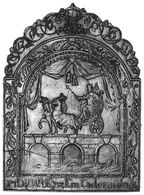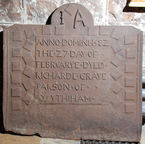-
238
Description: Arched rectangular shaped central panel with bead-and-pellet edging on a wide fillet; crowned figure, holding a sceptre in his right hand, sitting in a chariot drawn to the left by two, caparisoned horses with ostrich feather head-dresses; the whole upon a three-arched bridge with keystones and a string course, waves beneath; above, swagged drapery with two tassels hanging from the centre; arched rectangular shaped border with fillet edging, symmetrical, descending oak leaf and acorn branches, with a looped 'W' in each shoulder; inscription at base; on top, symmetrical scrolled plant tendrils and berries. A single central vertical plankline.
Notes: One of a series produced in the same year. All incorporate the looped 'W' motif which may be intended to identify the pattern maker. The design is derived from a personification of Europe, one of a set of playing cards entitled Jeu de la Géographie, designed by Stefano della Bella for Louis XIV. The inscription translates as 'God is our strength'.
Copies of this fireback are known.
Inscription: 17 DVW Ydyw Ein Cadernid 24
- Decoration tags:
- 'Dutch' (shape)
- fillet (edging)
- whole carved pattern
- planklines
- pictorial
- allegorical
- text
- animals
- humans
- objects
Manufactured: in 1724 in England.
Current location: Tredegar House, Pencarn Way, Duffryn, Newport, Gwent, Wales.
Museum number: F81.233 (part of the Welsh National History Museum museum group)
- Attached to series:
- 1724 series
- Welsh inscription series
- British 'Dutch' style firebacks
-
928
Description: Carved wooden fireback pattern. Arched rectangular central panel with astragal and fillet edging; Phaëton riding Apollo’s chariot across the skies, the sun to the left behind clouds, a lion on ground below, between two trees; arched rectangular border with fillet edging; trailing convolvulus leaves surround the central panel.
Notes: The illustration upon which the design has been based has not been identified, save that it figures in book II of Ovid's Metamorphoses. The convolvulus border is a common feature of this series of firebacks; given to the Sussex Archaeological Society by the Rev. J. Bickersteth.
- Decoration tags:
- 'Dutch' (shape)
- fillet (edging)
- whole carved pattern
- planklines
- pictorial
- mythological
- animals
- humans
- objects
Manufactured: in the early-18th century in England.
Current location: Anne of Cleves House, Southover High Street, Lewes, East Sussex, England.
(part of the Sussex Archaeological Society museum group)
Citation: Baines, J. M., 1958, Wealden Firebacks (Hastings Museum).
Citation: Dawson, C., 1903, 'Sussex Iron Work and Pottery', Sussex Archaeological Collections, 46, pp. 1-54.
- Attached to series:
- Patterns
- TAN series
-
548
Description: Arched rectangular central panel with bead edging; female figure, a crown above her head, holding two snakes; arched rectangular border with fillet edging; top centre, knot of ribbon with festoons of pomegranates suspended therefrom via a ring on each shoulder of the plate; at the bottom, two crossed palm fronds; on top, symmetrical arrangements of swirled foliage; on each side, a plain rectangular panel with fillet edging.
Notes: Possibly the allegorical figure of Democracy; the form of the palm fronds and the swirled foliage on top suggest a common pattern-maker with the TAN series and the Mayfield 'Dutch' series. Mitford collection, Petworth House.
- Decoration tags:
- 'Dutch' (shape)
- fillet (edging)
- whole carved pattern
- extension panels
- pictorial
- allegorical
- humans
Manufactured: in the early-18th century in England.
Current location: Petworth House, Petworth, West Sussex, England.
Museum number: NT/PET/M/102 (part of the National Trust museum group)
- Attached to series:
- British 'Dutch' style firebacks
- TAN series
-
806
Description: Rectangle with curved shoulders and low arch joined with concave curves; fillet and ogee moulded edging; central Tudor royal shield surrounded by garter, with crown above and lion and dragon supporters; royal initials either side of crown; lower right, inclined rectangular stamp of a dog; extended variant.
Notes: On clearer examples the garter motto has ‘EQVI’ instead of ‘HONI’, making it meaningless; possibly ‘EQVI’ was a mis-transcription of ‘HONI’; the crown is distinctly continental in form; a much-copied fireback.
Copies of this fireback are known.
Inscription: E R [Garter motto illegible]
Arms: Tudor royal - Elizabeth I
- Decoration tags:
- rectangular with round arch (shape)
- fillet and ogee (edging)
- carved stamps
- individual letters
- armorial
- royal
- text
- animals
Manufactured: in the mid- to late-16th century possibly in the Forest of Dean area of England.
Current location: in private hands, Salfords, Surrey, England.
-
798
Description: Arched rectangular shape with canted top corners; astragal-and-fillet and cavetto moulded strip on each side, angled at top; raised central square panel bearing main inscription in sans-serif characters justified to left (2s formed like Zs); irregular arrangement of small ‘serrated’ square stamps repeated 29 times in two vertical groups of 12 on each side of the inscription panel (6 on the outside, side to side, 6 on the inside, roughly corner to corner); 2 squares, side to side, below each side of the arch, above the inscription panel; 1 square at top of arch between non-matching initials.
Notes: The inscription is the same as on the iron plate above the grave of Richard Gray in Withyham church; another fireback, said to have the same inscription, was formerly at Wolvesey Palace, Winchester, and later in Winchester Museum, but is now missing; the moulding strips are likely to have been derived from furniture. Frances Ashbie and Richard Graye's godson, Richard, the son of William Ashbie, were among the beneficiaries of Richard Graye's will and the initials, IA, on the fireback may relate to another member of that family. The fireback was noted at Sompting, near Lancing, West Sussex, in the 1820s.
Inscription: I A / ANNO·DOMINI·1582 / THE·27·DAY·OF·· / FEBRVARYE·DYED· / RICHARDE·GRAYE / PARSON·OF· · / WYTHIHAM·
- Decoration tags:
- rectangular with round arch (shape)
- complex, furniture-derived (edging)
- carved stamps
- carved pattern panels
- individual letters
- text
Manufactured: in 1582 probably at Hamsell Furnace, Rotherfield in the Weald area of England.
Current location: St Michael's church, Withyham, East Sussex, England.
Citation: Arnold, F., 1871, 'Withyham Monumental Slab', Sussex Archaeological Collections, 23, pp. 320-1.
- Attached to series:
- Richard Graye inscription series
- Epitaph firebacks




